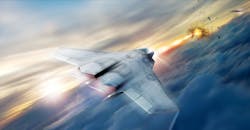Lockheed Martin Developing Compact Airborne Laser
Lockheed Martin has drawn a $26.3-million contract to design, develop, and produce a high-power fiber-laser weapon system for use on tactical fighter jets. The award, made by the U.S. Air Force Research Lab (AFRL), is part of that Self-protect High Energy Laser Demonstrator (SHiELD) program, and is a major step forward in the maturation of protective airborne laser systems.
Lockheed is one of the primary developers of aircraft for U.S. defense programs, including the F-35 Lightning II Joint Strike Fighter. The company noted it has been developing laser weapon systems for more than 40 years. The new project, known as Laser Advancements for Next-generation Compact Environments (LANCE), draws on past developments, including the ATHENA system, the ALADIN laser, and programs like the U.S. Army's Robust Electric Laser Initiative (RELI).
The AFRL, headquartered at Wright-Patterson AFB in Dayton, Ohio, is a scientific research organization operated by the United States Air Force Materiel Command and charged with identifying, developing, and integrating affordable aerospace warfighting technologies, and planning and executing the Air Force science and technology program.
The Lockheed contract is part of AFRL's Self-protect High Energy Laser Demonstrator (SHiELD) program, and is described by the contractor as “a major step forward in the maturation of protective airborne laser systems.”
AFRL plans to test the laser system on a tactical fighter jet by 2021.
"Lockheed Martin continues to rapidly advance laser weapon systems and the technologies that make them possible," stated Dr. Rob Afzal, senior fellow of laser weapon systems. "We have demonstrated our ability to use directed energy to counter threats from the ground, and look forward to future tests from the air as part of the SHiELD system."
The SHiELD program includes three subsystems:
• SHiELD Turret Research in Aero Effects (STRAFE), the laser-beam control and targeting system, which will direct the laser onto the target;
• Laser Pod Research & Development (LPRD), the pod mounted on the tactical fighter jet, which will power and cool the laser; and,
• LANCE, the high-energy laser, for disabling adversary targets. It is being designed to operate in a compact environment, so Lockheed has focused on developing a compact, high-efficiency laser to address size, weight, and power constraints.
"Earlier this year, we delivered a 60-kW-class laser to be installed on a U.S. Army ground vehicle,” Afzal noted. “It's a completely new and different challenge to get a laser system into a smaller, airborne test platform.
